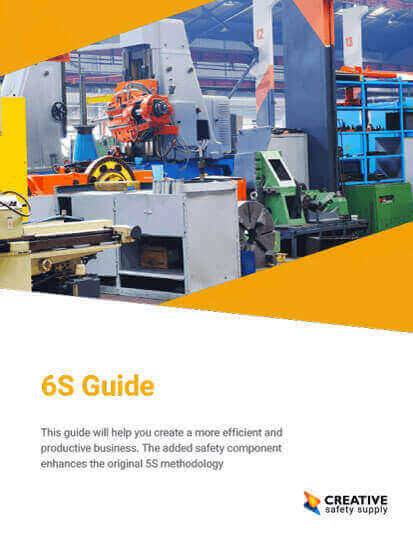
In the realm of workplace organization, efficiency, and employee well-being, the rules of 6S safety emerge as guiding principles that shape organizational success. As organizations strive to create environments that prioritize safety, enhance efficiency, and foster a culture of continuous improvement, understanding and embracing the rules of 6S safety become imperative. In this comprehensive exploration, we delve into the intricacies of these rules and share some examples of practical 6S implementation, examining how they harmonize with Lean principles and reshape workplaces into bastions of safety and excellence.
The Essence of 6S Safety Rules
At the core of 6S safety rules lies a set of principles that dictate the processes and behaviors required to create a safe, organized, and efficient work environment. These rules extend beyond mere guidelines; they serve as the compass that steers organizations toward a culture that values safety as an integral aspect of daily operations.
Rule 1: Sort - Prioritizing Necessity
The first rule, "Sort," is the foundation upon which the entire 6S safety framework is built. This rule mandates the separation of essential items from non-essential ones. By removing clutter and excess, organizations create an environment that minimizes the risk of accidents caused by stumbling over unnecessary items. The rule of Sort enforces the principle that a clutter-free workspace is a safer workspace.
Rule 2: Set in Order - Ensuring Accessibility
"Set in Order" emphasizes arranging items in a logical and accessible manner. The rule guides employees to place tools, equipment, and materials where they are easily reachable, reducing the risk of overstretching or awkward movements that could result in injuries. This rule underscores the importance of organization in preventing accidents and enhancing efficiency.
Rule 3: Shine - Cultivating Cleanliness
The third rule, "Shine," centers on cleanliness and regular maintenance. A clean workspace not only enhances employee morale and productivity but also contributes to safety. By promptly addressing spills, removing debris, and maintaining equipment, organizations create an environment free from potential hazards that could lead to accidents.
Rule 4: Standardize - Creating Consistency
"Standardize" introduces the imperative of consistent processes and protocols. This rule ensures that the organization's efforts in Sort, Set in Order, and Shine are upheld over time. Standardization not only maintains an organized and safe workspace but also prevents lapses that could lead to accidents or inefficiencies.
Rule 5: Sustain - Perpetuating Excellence
"Sustain" underlines the ongoing commitment to upholding the achieved standards. This rule compels organizations to instill a culture of continuous improvement, where safety and efficiency remain paramount. By engaging employees in sustaining the 6S safety practices, organizations ensure that excellence endures beyond the initial implementation.
Rule 6: Safety - Safeguarding Well-being
The final rule, "Safety," epitomizes the core mission of 6S safety. This rule mandates the identification and mitigation of potential hazards. Providing the necessary personal protective equipment (PPE), establishing safety protocols, and training employees in safety practices are vital components of this rule. Safety serves as a foundational value that preserves employee well-being.
The Symbiosis of 6S Safety and Lean Principles
The rules of 6S safety share a symbiotic relationship with Lean principles, forging a harmonious alliance that propels organizations toward optimal operations:
- Waste Reduction: Rule 1 - Sort, aligns with Lean's focus on minimizing waste by eliminating non-essential items.
- Efficiency Enhancement: Rule 2 - Set in Order, and Rule 4 - Standardize, resonate with Lean's objective of creating efficient workflows and standardized processes.
- Continuous Improvement: Rule 5 - Sustain, mirrors Lean's commitment to continuous improvement by fostering a culture of ongoing enhancement.
- Employee Well-being: Rule 6 - Safety, encapsulates Lean's emphasis on respecting and valuing employees as a critical resource.
Leadership's Role in Enforcing 6S Safety Rules
Leadership plays a pivotal role in the successful implementation of 6S safety rules. Their commitment is demonstrated through resource allocation, vocal support, and active participation in the safety journey. When leaders embody and reinforce the 6S safety rules, they communicate their dedication to employee well-being and operational excellence.
Benefits of Adhering to 6S Safety Rules
Organizations that diligently adhere to the rules of 6S safety experience a wide array of tangible and intangible benefits:
- Enhanced Safety Culture: The rules instill a culture where safety is deeply ingrained in daily operations, fostering a proactive approach to identifying and mitigating hazards.
- Streamlined Operations: Adhering to 6S safety rules streamlines processes, reducing inefficiencies, minimizing errors, and optimizing resource utilization.
- Employee Engagement: The involvement of employees in maintaining and adhering to safety rules fosters a sense of ownership and engagement, contributing to their job satisfaction.
- Cost Savings: Reduced accidents and operational inefficiencies lead to significant cost savings, positively impacting the organization's financial bottom line.
Similar Questions
- What is 6S Safety?
- What is the Definition of 6S?
- How Does 6S Safety Work?
- How Can 6S Improve Workplace Safety and Reduce Incidents?
- When is the Best Time to Set Up a 6S Safety Program?
- Why should you implement 6S in your workplace?
- Can You Use a Checklist for 6S?
- How does employee engagement affect 6S implementation?
- What are Some Examples of 6S?

